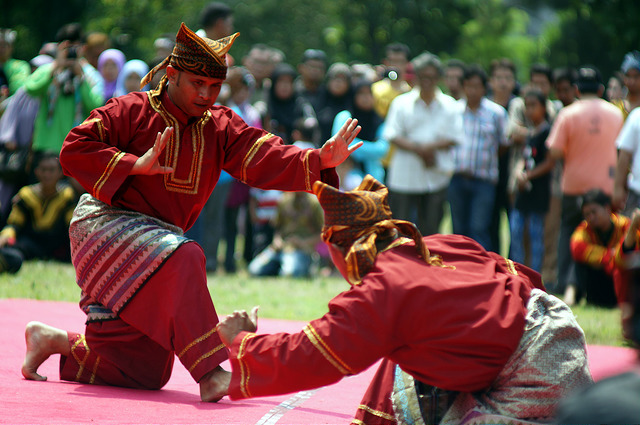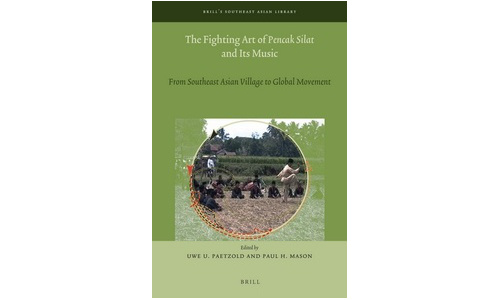The Fighting Art of Pencak Silat and Its Music reveals the multitude of martial arts practices and celebrations
Pencak silat is the popular name for a rich variety of martial arts practices originating from Indonesia and Malaysia. Pencak silat is also the source of inspiration for a number of theatre and dance traditions, including Randai from West Sumatra and Jaipongan from West Java. The Fighting Art of Pencak Silat and Its Music is an exceptional edited volume on Southeast Asian martial arts and music. With more than a dozen chapters, the ethnographic material covered in this volume spans the Indo-Malayan archipelago with a concentration of research on Indonesia.
Martial arts, religion and music
The chapters range across these themes and geographies – featuring the research of local Southeast Asian scholars, including Bussakorn Binson and Zahara Kamal, alongside international scholars such as Margaret Kartomi, Henry Spiller, Kirstin Pauka and Sean Williams. Not only have the editors Uwe Paetzold and Paul Mason done a commendable job bringing all these scholars together, this collection takes seriously the study of martial arts as an academic research topic and promotes the concurrent study of music, dance and culture as a rigorous form of ethnographic analysis.
Jean-Marc De Grave writes about the Java-centric standardisation of pencak silat within nationalist political agendas and internationalising political desires. Uwe Paetzold investigates how Indonesian artists and pencak silat organisations try to mobilise their art for internationalisation and to recruit international clientele, which has inevitably resulted in the simplification of pencak silat. Discussing the spread of pencak silat outside Indonesia and Malaysia, Bussakorn Binson examines the practice of silat among Muslim migrants in southern Thailand. With a granular analysis of the percussion accompaniment for silat, Gisa Jahnichen studies Malaysian pencak silat groups in Kelantan and Sabah, discussing the philosophical background and cultural reality of pencak silat in the Malay Archipelago. Kirstin Pauka discusses how university students in Hawaii learn and perform Randai, a form of traditional theatre from West Sumatra inspired by the movements and stories of local martial arts traditions.
A significant number of chapters focus mainly on the performance of pencak silat in Indonesia. Paul Mason contributes two intriguing chapters: the first on martial arts performances during religious festivals among the Minangkabau in West Sumatra, and the second looking inside martial arts schools and competitions among the Sundanese in West Java. These two art forms are similar in character yet so different in the way they are performed and played out in relation to their musical accompaniment. Zahara Kamal documents the little known Sufi form of martial arts called Luambek in West Sumatra where movement is guided by singing and where performers refrain from physical contact. Ako Mashino studies the music and movement of Muslim silat performances during Islamic festivals in Bali, which play an instrumental role in carving a Muslim/Balinese cultural identity. Henry Spiller brings the spiritual dimension of martial arts into the fold in his chapter on the relationship between drumming and movement in West Javanese pencak silat. Sean Williams discusses Sundanese regional identity and Jaipongan, a seductive and playful dance form strongly related to pencak silat in movements and orchestration. Margaret Kartomi revisits field notes to document music and martial arts practices in the Riau islands.

One of Paul Mason's chapters explores martial arts performances in religious festivals in Minangkabau. (anwijaya/Flickr)
Martial arts enthusiasts may have mixed feelings about this book. This is not a training manual for fighting techniques. The chapters will give the reader a deeper appreciation of the social context, historical development and aesthetic nuances of different genres of pencak silat and silat-inspired performance arts. The Fighting Art of Pencak Silat and Its Music will interest anthropologists, philosophers, cultural theorists, Southeast Asian scholars, and Indonesianists, not to mention musicians, dancers and other performance artists.
Ethnomusicologists and dance anthropologists in particular will find this volume an indispensable addition to their libraries. As a bonus, upon buying the book purchasers are given exclusive access to corresponding media materials available online. The book includes an abundance of colourful figures and photos, an impressive glossary and an index of names and terms to help the selective reader source relevant material. The editors have gone to great lengths to engage with scholars from a variety of language backgrounds and the diversity of the content reflects this. As a unique contribution to the study of music, martial arts, theatre, dance, and cultural life in Southeast Asia, this book should be applauded for its breadth of scholarship and depth of analysis.
Alfira O’Sullivan (info@suaraindonesiadance.com.au) is Artistic Director of Suara Indonesia Dance, a Sydney-based Indonesian performance troupe which has brought Indonesian performing arts to audiences throughout Australia, Indonesia, the Middle East and Europe.
